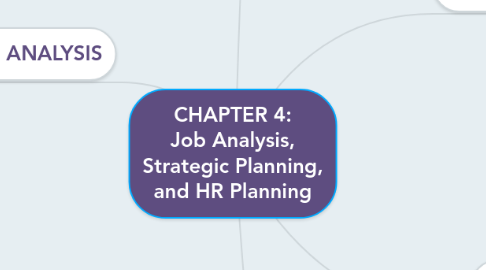
1. JOB ANALYSIS
1.1. Definition: Job analysis is the systematic process of determining the skills, duties, and knowledge required for performing jobs in an organization
1.2. Reasons for Conducting Job Analysis
1.2.1. Staffing
1.2.2. Training and Development
1.2.3. Performance Appraisal
1.2.4. Compensation
1.2.5. Safety and Health
1.2.6. Employee and Labor Relations
1.2.7. Legal Considerations
1.3. Types of Job Analysis Information
1.3.1. Work activities
1.3.2. Worker-oriented activities
1.3.3. Machines, tools, equipment, and work aid used
1.3.4. Personal requirements
1.4. Job Analysis Method
1.4.1. Questionnaires
1.4.2. Observation
1.4.3. Interviews
1.4.4. Employee recording
1.4.5. Combination of methods
1.4.6. Other methods (TABLE 4-1)
1.5. Conducting Job Analysis
1.5.1. People who participate in job analysis should include, at a minimum: - Employee - Employee’s immediate supervisor
1.6. Job Description
1.6.1. - Document that states tasks, duties, and responsibilities of job - Vitally important job descriptions are both relevant and accurate
1.6.2. Content of Job Description
1.6.2.1. Job Identification – Job title, department, reporting relationship, and job number or code
1.6.2.2. Job Analysis Date – Aids in identifying job changes that would make description obsolete
1.6.2.3. Job Summary – Concise overview of job
1.6.2.4. Duties Performed – Major duties
1.7. Job Specification
1.7.1. - Should reflect minimum, not ideal qualifications for particular job - Job specifications are often included as major section of job descriptions
1.7.2. Problems if job specifications are inflated
1.7.2.1. May systematically eliminate minorities or women from considerations
1.7.2.2. Compensation costs will increase
1.7.2.3. Job vacancies will be harder to fill
1.8. Standard Occupational Classification (SOC) & O*NET, the Occupational Information Network
1.8.1. The SOC's substantive structural changes are based on actual changes in the nature or organization of work activities being performed in the economy (TABLE 4-3)
1.8.2. O*NET, the Occupational Information Network, is a comprehensive, government-developed database of worker attributes and job characteristics (TABLE 4-4)
1.9. Job Analysis for Team Members
1.9.1. With team design, there are no narrow jobs
1.9.2. Work departments do is often bundled into teams
1.9.3. Last duty shown on proverbial job description, “And any other duty that may be assigned,” is increasingly becoming THE job description.
1.10. Job Analysis and the Law
1.10.1. Fair Labor Standards Act
1.10.2. Equal Pay Act
1.10.3. Civil Rights Act
1.10.4. Occupational Safety and Health Act
1.10.5. Americans with Disabilities Act (ADA)/ADA Amendments Act
2. STRATEGIC PLANNING
2.1. Definition: Strategic planning - Process by which top management determines overall organizational purposes and objectives and how they are to be achieved
2.2. Strategic planning at all levels can be divided into four steps 1. Determination of the organizational mission 2. Assessment of the organization and its environment 3. Setting of specific objectives or direction 4. Determination of strategies to accomplish those objectives
3. HR PLANNING
3.1. Definition: Human resource planning (workforce planning) is the systematic process of matching internal and external supply of people with job openings anticipated in the organization over a specified period of time
3.2. Two components of HR Planning: - Requirements forecast - Availability forecast
3.2.1. Requirements forecast: Determining the number, skill, and location of employees the organization will need at future dates in order to meet its goals
3.2.1.1. Zero-Base Forecast
3.2.1.2. Bottom-Up Forecast
3.2.2. Availability forecast Determination of whether the firm will be able to secure employees with the necessary skills, and from what sources
